
An echinoderm is any deuterostomal animal of the phylum Echinodermata, which includes starfish, brittle stars, sea urchins, sand dollars and sea cucumbers, as well as the sessile sea lilies or "stone lilies". While bilaterally symmetrical as larvae, as adults echinoderms are recognisable by their usually five-pointed radial symmetry, and are found on the sea bed at every ocean depth from the intertidal zone to the abyssal zone. The phylum contains about 7,600 living species, making it the second-largest group of deuterostomes after the chordates, as well as the largest marine-only phylum. The first definitive echinoderms appeared near the start of the Cambrian.

Crinoids are marine invertebrates that make up the class Crinoidea. Crinoids that remain attached to the sea floor by a stalk in their adult form are commonly called sea lilies, while the unstalked forms, called feather stars or comatulids, are members of the largest crinoid order, Comatulida. Crinoids are echinoderms in the phylum Echinodermata, which also includes the starfish, brittle stars, sea urchins and sea cucumbers. They live in both shallow water and in depths over 9,000 metres (30,000 ft).
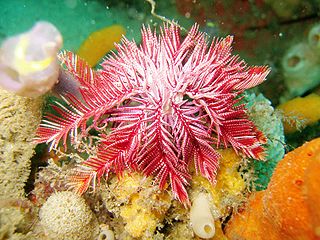
Articulata are a subclass or superorder within the class Crinoidea, including all living crinoid species. They are commonly known as sea lilies or feather stars. The Articulata are differentiated from the extinct subclasses by their lack of an anal plate in the adult stage and the presence of an entoneural system. Articulata first appeared in the fossil record during the Triassic period although other, now extinct crinoid groups, originated in the Ordovician.

Crinozoa is a subphylum of mostly sessile echinoderms, of which the crinoids, or sea lilies and feather stars, are the only extant members. Crinozoans have an extremely extensive fossil history, which may or may not extend into the Precambrian.

Comasteridae is a family of crinoids.
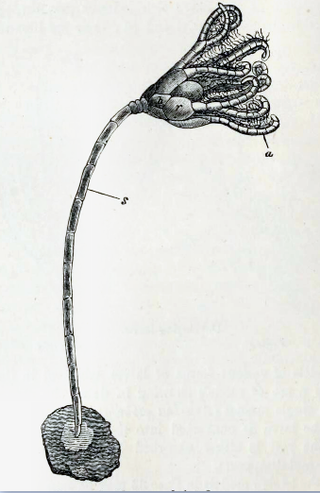
Antedon bifida is a species of crinoid in the family Antedonidae commonly known as the rosy feather star. It is found in north west Europe.

Comatulida is an order of crinoids. Members of this order are known as feather stars and mostly do not have a stalk as adults. The oral surface with the mouth is facing upwards and is surrounded by five, often divided rays with feathery pinnules. Comatulids live on the seabed and on reefs in tropical and temperate waters.

Davidaster rubiginosus, the orange sea lily, is a species of crinoid in the family Comatulidae. At one time it was classified as Nemaster rubiginosa but the World Register of Marine Species has determined that the valid name is Davidaster rubiginosus. It is found on reefs in the tropical western Atlantic and the Caribbean Sea.
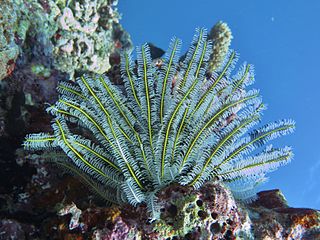
Comaster schlegelii, the variable bushy feather star, is a crinoid in the family Comatulidae. It was previously classified as Comanthina schlegeli but further research showed that it was better placed in the genus Comaster. It is found on shallow water reefs in the western Pacific Ocean.

Anneissia bennetti, the Bennett's feather star, is a species of crinoid belonging to the family Comatulidae. It is found in shallow water in the Indo-Pacific between northern Australia and southeast Asia.

Antedon mediterranea is a species of stalkless crinoid in the family Antedonidae, commonly known as the Mediterranean feather star. It is found on the seabed at moderate depths in the Mediterranean Sea. It is a filter feeder and captures plankton with its long feathery arms.

Leptometra celtica is a marine invertebrate and species of crinoid or feather star of the Leptometra genus in the family Antedonidae. It is found in the Atlantic Ocean around the coasts of north west Europe. The presence of L. celtica and L. phalangium is considered to be a good indication of nearby shelf breaks, general bottom currents, and areas of high gross productivity as they are suspension-feeders, hence their proliferation in productive environments.
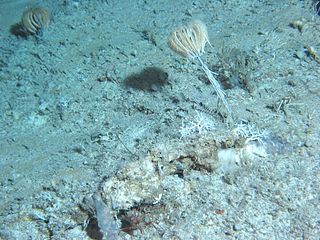
Endoxocrinus parrae is a species of stalked crinoids of the family Isselicrinidae. It is the most commonly found isocrinine species in west Atlantic Ocean.
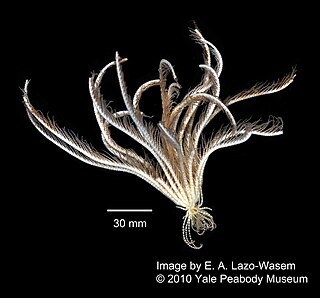
Promachocrinus kerguelensis is a species of free-swimming, stemless crinoids. It was the only member of its genus until several species were discovered in 2023. P. keruguelensis a coldwater crinoid which is found in the seas around Antarctica and surrounding island groups, including under the sea ice.

Aporometridae is a monotypic family of crinoids, the only genus being Aporometra, which contains three species, all endemic to the seas around Australia.

Notocrinus virilis is a marine invertebrate, a species of crinoid or feather star in the family Notocrinidae. It is found in deep water in the Southern Ocean around the coasts of Antarctica and adjacent islands. A sea snail sometimes parasitizes it.

Aporometra paedophora is a marine invertebrate, a species of crinoid or feather star in the family Aporometridae. It was first found at a depth of 22 fathoms off the Manning River on the New South Wales coast. Other specimens were found off the coast of Bunbury, Western Australia at depths between 9 and 15 m. Based on morphological evidence of four specimens of A. paedophora, Helgen & Rouse believe that this may not be a separate species from Aporometra wilsoni.
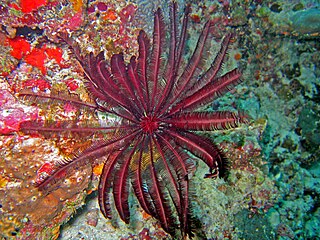
Cenometra bella is a species of crinoids belonging to the genus Cenometra. They can have up to 30 arms and can be of variable colours but are often characterised by a marked contrast between the extending free-arms and the feathery pinnules. This species clings to its support and moves around by its feet-like cirri.

Promachocrinus is a genus of free-swimming, stemless crinoids. It was a monotypic genus, with the only species in the genus being Promachocrinus kerguelensis, until the discovery of four new species, establishment of two others previously described and the transfer of another species to the genus in 2023. Known for being coldwater crinoids, members of Promachocrinus are typically found in the seas around Antarctica and surrounding island groups, including under the sea ice. Previously known for having 20 arms, two of the species now included in the genus have 10 arms. Many of the species are circum-Antarctic and can be difficult to tell apart without DNA sequencing.
Promachocrinus fragarius, commonly known as the Antarctic strawberry feather star, is a species of stemless, free-swimming crinoid. It was one of several new species of Promachocrinus to be described in 2023. The discovery of the species gained significant media attention.
















